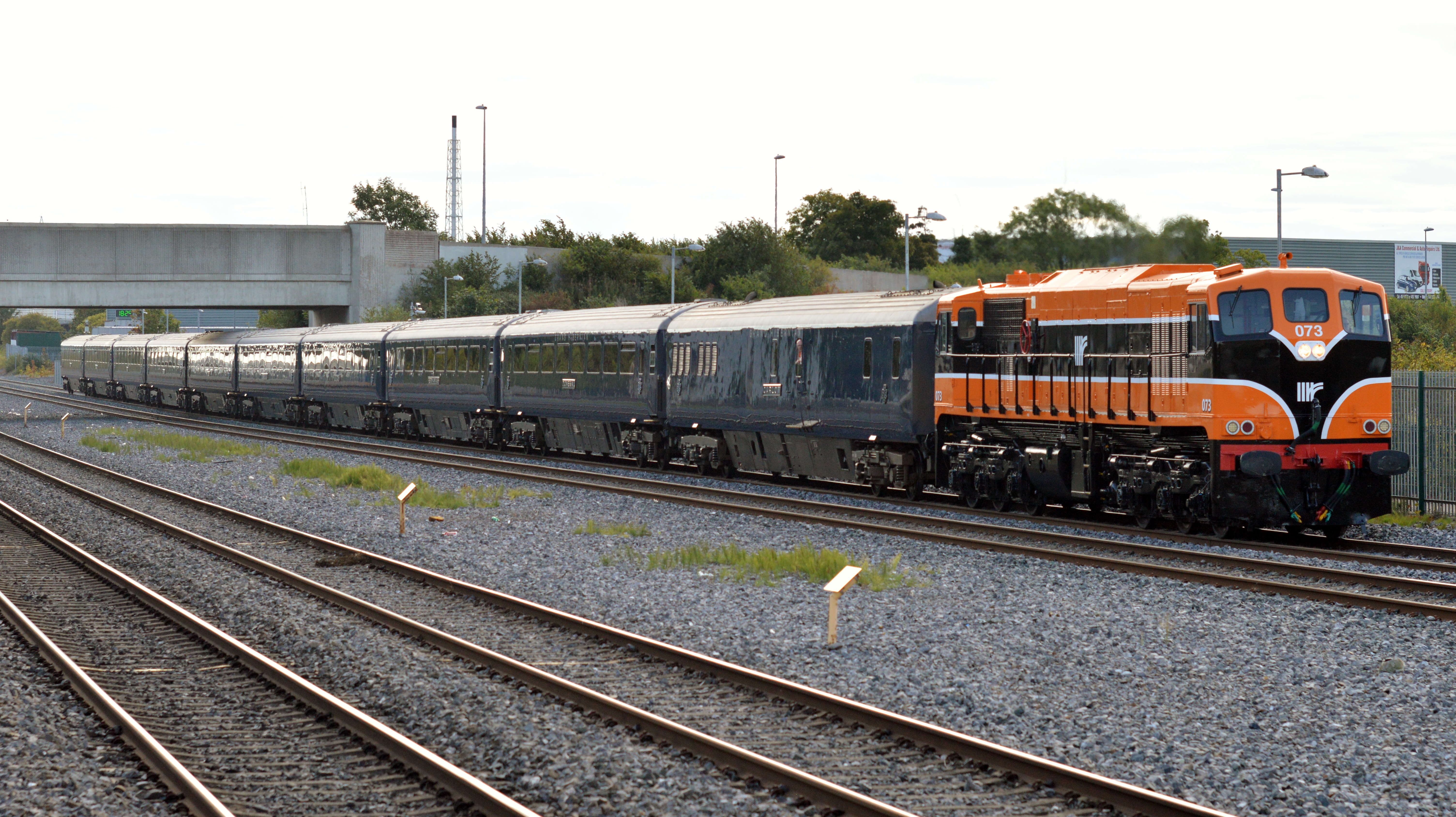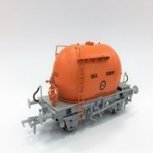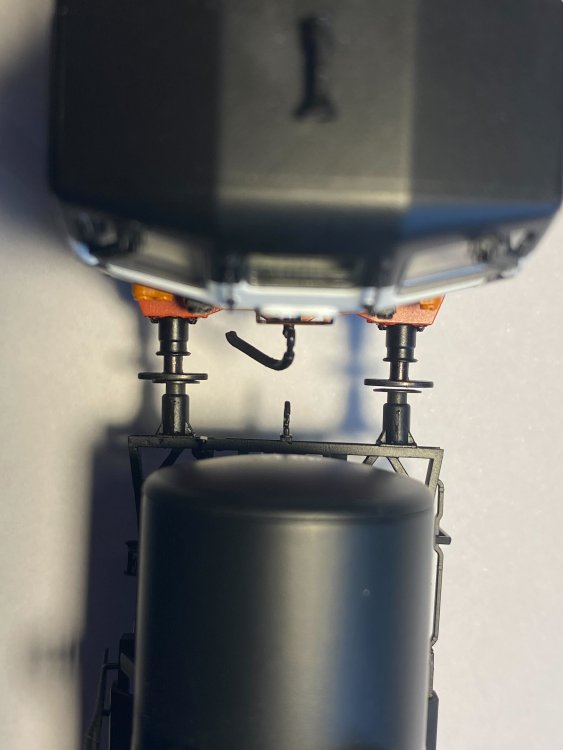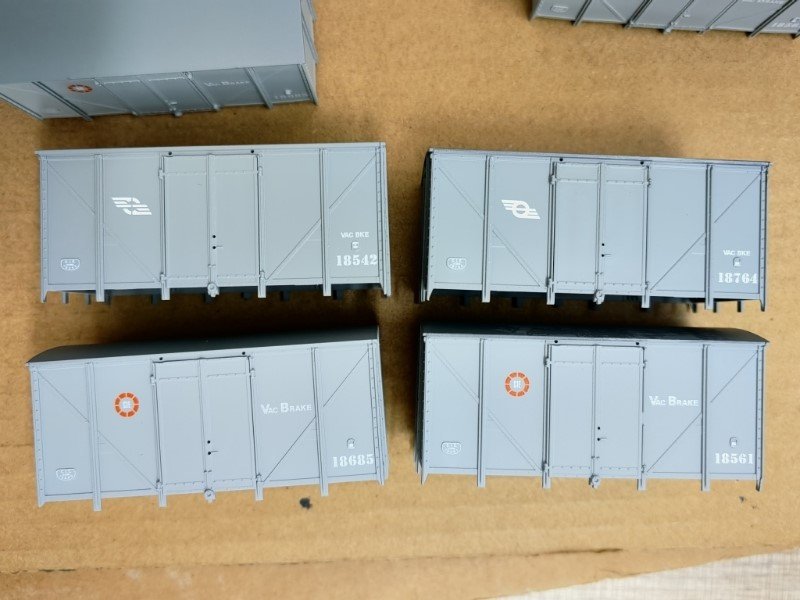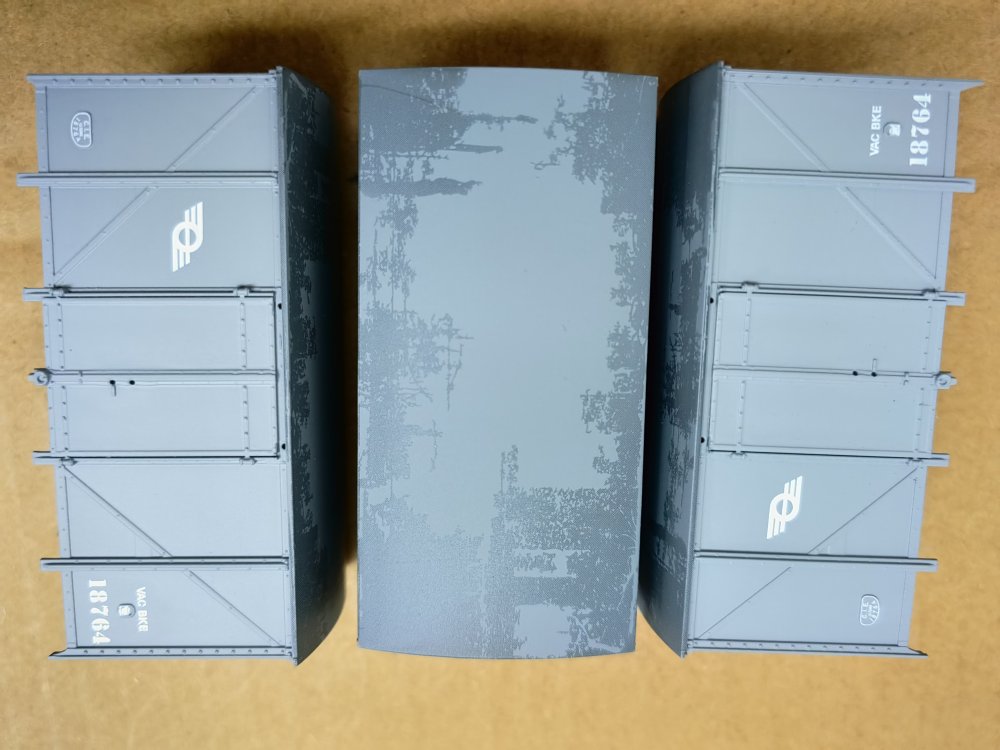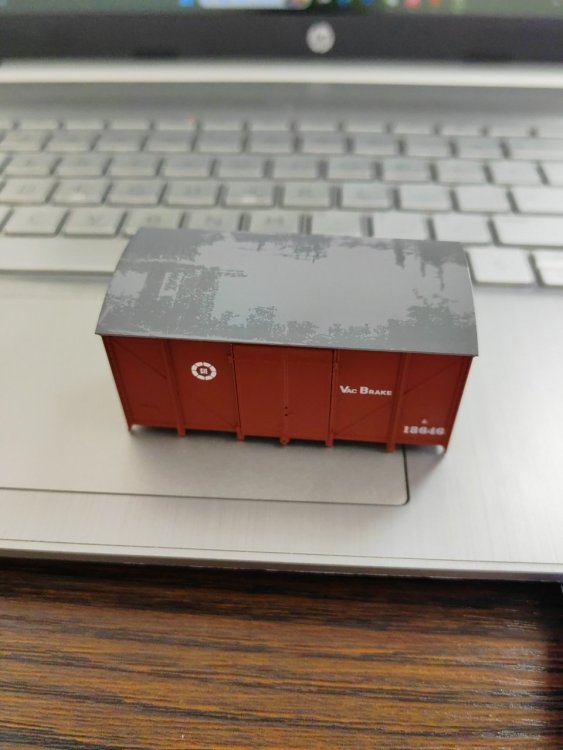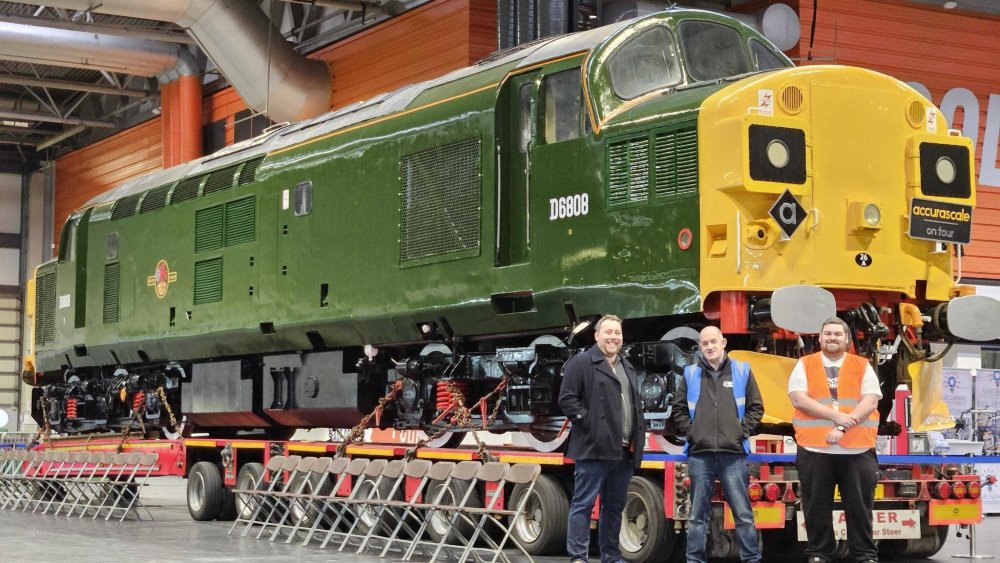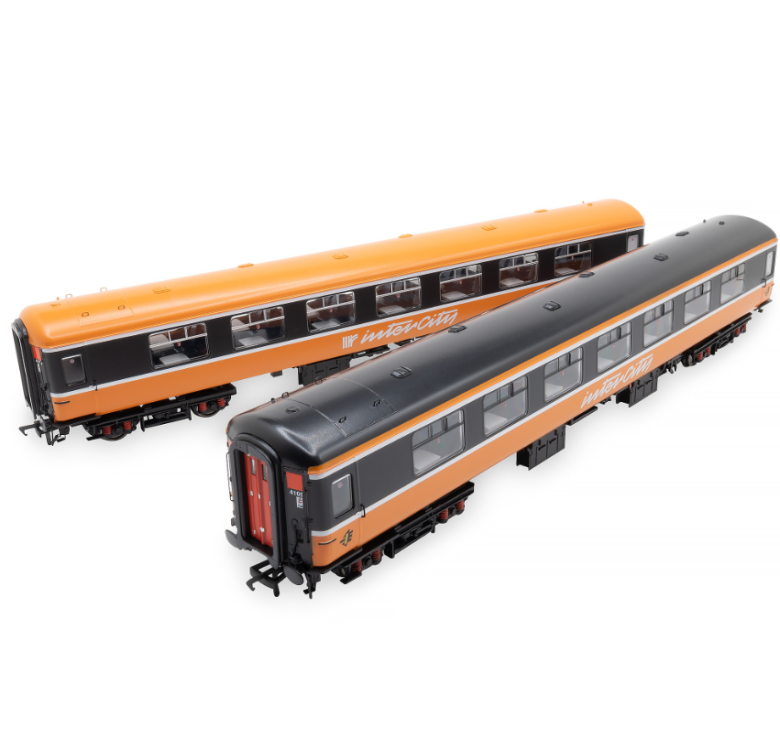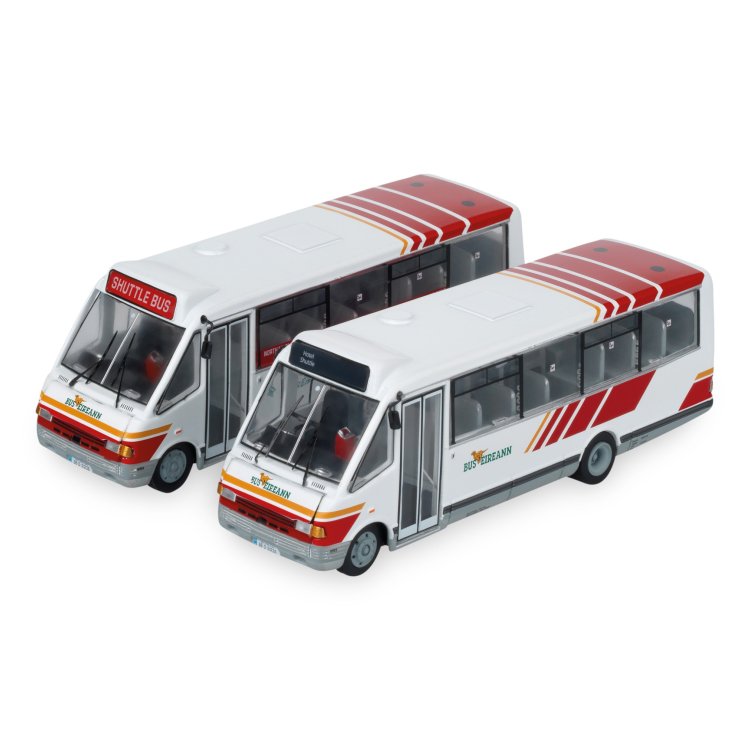-
Posts
7,089 -
Joined
-
Last visited
-
Days Won
250
Content Type
Profiles
Forums
Events
Gallery
Blogs
Store
Community Map
Everything posted by Warbonnet
-
Hi Dave, The Park Royal’s as it stands is done to prototypical Irish spacing. This is due to the future development of our range of both coaches and motive power which will become apparent in the future. Cheers! Fran
-
Hi Al, It is up to you what you decide to do, but note that a lot of Irish models are made this way, and we tried best to facilitate everyone, but that is impossible. If you wish to cancel future orders please email us with your order number, but it is also worth remembering that your 141 class locos, cravens, 071 etc also has this and it is very unlikely models of this quality of these wagons will ever be made again, being very niche to begin with. Cheers! Fran
-
Hi folks, As you can see below, lined up with a 141 they match perfectly. I believe this is the same for 071s, Cravens and 201s too from another manufacturer. Not to mention Woolwich moguls, jintys etc from this era. While not in scale position, it does match the majority of locos made and looks more at home on 00 track, which we find that 99% of our customers prefer and use. We also considered the historical usage of these wagons in mixed trains, such as cattle wagons, tankers and vans which many modellers already have represented on their layouts using re-liveried UK models, and we felt it odd to have our wagons have a different buffer spacings in an otherwise uniform mixed train. We went for a compromise as a result. It is a case of "Damned if you do, damned if you dont" I'm afraid. Of course, for the finescaler and top modellers out there, they can be repositioned with some modelling if they choose to do so. We try to be considerate as possible for those who wish to go finescale, hence the new 28mm axles that make 21mm gauge easy, put sometimes we have to make a choice We showed off all samples early on and heard no objections, so we pushed on with production. Cheers! Fran
- 178 replies
-
- 13
-

-

-
Hi everyone, Great news! Our latest wagon project from the Bulleid wagon project, the ubiquitous CIE "H Van", is now at decoration stage! These first samples are currently being put together and will be sent to us in the coming week. We will show off the completed samples when they arrive, but these images give you a flavour of what's to come! We're still on track for a Q4 2024 delivery and pre-orders are coming in fast. Secure yours for a no money down below, with each triple pack priced at just €89.95 each, with 10% off when you order two packs or more and free Irish postage and packaging. An incredible piece of value for money for highly detailed, accurate Irish wagons. Pre-order yours here: https://irishrailwaymodels.com/collections/h-van Cheers! Fran
- 133 replies
-
- 11
-

-

-
decorated park royals and full update due in the next 4 weeks!
-
Our recent announcement of our 21 ton BR hopper wagons, later designated HTO and rebodied and designated HTV has gone down very well indeed with modellers. Considering it fills a long standing and much needed gap in the wagon range of 00/4mm modellers, it is unsurprising how popular they have been if our pre-orders are anything to go by! Of course, even though the HTO and HTVs were very much seen as a humdrum BR standard wagon in grey and bauxite liveries, they did go in differing directions later on in their careers, with industrial and engineering operations making use of them later in their lives. This always gives us some great ideas for some limited edition, one time run "Accurascale Exclusives" packs, and today we present two very different packs to you for consideration; our ZDV engineers triple pack, and our ICI internal user pack! ZDV Pack With the transfer of domestic coal transport to the air braked wagon fleet of HEA wagons in the 1980’s, the HTV fleet were in terminal decline. British Rail engineers saw this and upon evaluation deemed many wagons to have a reasonable amount of serviceable life left in them. Engineering trains were typically vacuum braked and employed ex squadron service wagons in new roles and the HTV’s were no different. Whilst many wagons were converted to box-body spoil wagons such as Clams and Rudds, some of the fleet retained their original bodywork either in cut down form to gain the Tope fishkind name or not altered at all and just receiving the ZDV TOPS code. Our pack of ZDV engineers wagons represent the latter. Photographs show these wagons in use variously in the late 1980’s and early 1990’s for carrying spoil at many infrastructure jobs across the country. The patch painting, rusty bodywork and chalked markings make these wagons stand out from the rest as being unloved, uncared for yet equally vital in maintaining the country’s railway network. ICI Pack ICI Lostock Soda ash works, Northwich is more well known as being the destination of the 1930’s built LMS bogie hoppers from Tunstead but their internal rail network had a number of other vehicles present. As well as a brace of Ruston 165 0-4-0 diesel shunters, there were a small number of ex BR rebodied HTV hoppers. These were used from their withdrawal in the 1980s well in to the 1990s for carrying “hot rocks”, hot, processed limestone around the plant during the production of Soda Ash (Sodium Carbonate) The Model Each wagon features a wealth of separately applied detail, from handrails on the diecast chassis and hopper ends to the intricate brake gear and hopper operating mechanism underneath, all museum quality detail and prototypical accuracy modellers now come to expect from our wagons and which is now our standard specification. As well as a diecast chassis with full hopper detail, each wagon rides on 26mm axles, which are 2mm in diameter, with pin points in brass bearing cups for ultimate smooth performance and ease of conversion to finescale tolerances. With the wagons announced later in development to curb waiting times, we're already at decoration stage and we are about to begin production of these wagons in the coming weeks. Delivery of the models to customers is currently estimated at Q3 2025. Both wagon packs will be a one off, limited production run in special presentation packaging like all models in the Accurascale Exclusives range. Each pack is priced at £99.95 and we're operating their usual 10% off when you buy two packs or more, along with a new offer of 15% when you buy 5 or more packs direct from our website. That means each wagon just costs £27.47 when you factor in loyalty points rewards and postage and packaging being free! They can of course be mixed with other HTO/HTV wagon packs in the launch range to get these discounts. Pre-order yours today for no money down via the link below. Pre-Order Your Accurascale Exclusives 21 Ton Hopper Packs Here! View the full article
-
- 2
-

-
Modellers awaiting our very new and very detailed Mark 1 56ft 11' coaches have been awaiting some news on these wonderful coaches. After some trials and tribulations, including something completely new which popped up to throw yet another curveball our way, we can confirm that production is complete on our BR blue and our Yellow Accurascale Exclusives tool van. Shall we take a closer look first? As you can see, they look pretty delicious! The further good news is that production is complete for these coaches and they're already on the way to us! They are due to land at our warehouse in the last week of August. So, that's the blue and the tool van. But, what about the carmine? Well, this is where it gets interesting. When we sign off for production of a new model, everything is correct; the details, the printing and of course, the colour. These act as a template for the factory to follow. Once production is completed, the factory sends us one of every model from the production run to check and sign off on. The Mark 1 coaches were no different. Sadly, the factory used an incorrect shade of carmine which did not match what we signed off on with the decorated sample. This means the whole carmine production batch was wrong. There was only one thing to do; remanufacture the coaches in the correct colour. Our factory partner, brilliant as always, rose to the challenge of this and stood over their error. They wanted it to be right as much as we did and have now fixed the issue for us. However, this does take time, and therefore the carmine coaches have been delayed slightly as a result. We are very sorry for this delay, but it was beyond our control. The good news is that the factory are almost finished the new carmine batch, and we will have a new delivery date for these in approx. 2 weeks time. We do know that they will be approx 4-6 weeks behind the blue and tool van coaches, but we will have a more specific date soon which we will send out to you as soon as we can. Our Maroon production run is still on course to be delivered Q1 2025 as per the original announcement. In the meantime, make sure you order these very special coaches below, or via your local stockist! As you can see above, you will be getting something rather special for your money! PRE-ORDER YOUR MARK 1 SUBURBAN COACHES HERE! View the full article
-
- 3
-

-
-
Thanks folks! Just to say that IR pack 1 is sold out, but we do have limited amounts of 2, 3, and 4 remaining in stock if you want to add to your fleet! Order here: https://irishrailwaymodels.com/collections/mark-2-coaches Cheers! Fran
-
He was just reporting that a 201 loco has gained some decals which may be of interest to modellers, not delivering a lecture on climate or botany. Let's keep the rants to a minimum please. Cheers! Fran (with moderator hat on)
-
Hi folks, As above, IR and IE Mark 2 Coaches Have Arrived! Great news! Our Mark 2b and Mark 2c coach packs in classic IR and IE orange and black livery have now arrived in stock! We will commence shipping of these models today and envisage that they will take a number of days to complete, so please bear with us. Fancy some? Well we have put some surplus stock back on sale which you can order below! These will be dispatched after shipping the pre-orders is complete. Order Now: https://irishrailwaymodels.com/collections/mark-2-coaches Cheers! Fran
-
Our recently announced BR 21 Ton Hopper Wagons have been met with great approval since we announced them last month. Our latest addition to our "Powering Britain" range of coal wagons fill a much needed and long standing gap in the OO/4mm RTR market. We're delighted to now reveal our decorated samples of these wagons, which, along with our Class 60, have been announced much later in development to aid cutting down on waiting times. Feast your eyes below! As you can see, they follow our usual approach of individual numbering and lettering, with great variety across each pack. We have even experimented with differing shades of grey to show faded and more recently applied paintwork to offer further variety throughout your rake. Modellers will be able to accept our wagons into traffic as per our initial estimate of Q3 2025. Pre-order yours today via your local retailer, or direct via our website where you can get 10% off when you order two or more packs and avail of free postage and packaging! Pre-order via the link below. Pre-Order Your 21 Ton HTO/HTV Hopper Wagons Here View the full article
-
- 1
-

-
It's been rather a long time since we offered any kind of update on our second ever steam locomotive; the vast group of detail variances that are the J67/68/69 "Buckjumper" class of locomotives. These variances alone which makes what seems to be a little tank engine quite the incredibly complex beast, and it has taken a long while to get it to the standard that we demand of all our models. However, when we received the decorated samples in recent weeks all we could say is; WOW! So, without further ado, check out these absolute beauties, and if you want to know more, keep scrolling to what we are fixing and find out when they are coming! Tasty, right? With any samples at this stage, there needs to be some corrections and tweaks made, and our beautiful little Buckjumpers are certainly no different. Thankfully, they're all relatively minor and already well under way. The drawbar hook will be changed to allow for easy fitting and removing of our exquisite 3 link/screw couplings. The destination boards are proving to be a bit of a tight fit, so these are being fine tuned ahead of release to make changing in and out more straightforward. Each model will get a full selection of destination boards included in the box. The chemical blackening on the buffers and wheels alone does not render them dark enough, so faces will be painted, and finish adjusted to a deep matt finish, just like the wheels on our beautiful Manor steam locomotives. This will give them a beautiful rich colour and make them look even more realistic. As ever, the application of paint highlights areas where tolerances are very tight. These have now been adjusted to take into account paint layers. Worst affected areas were the cab roof, the drilled holes where optional fit pipes need to go and the fitting of the door trim. The application of paint has also revealed witness marks where the moulds separate. This is entirely normal and highlights where the moulds need additional polishing. Additional paint application will also make the world of difference to the finished models. The design and fitting of the PCB was based on one example with a deeper internal recess on the smokebox door, which has affected the fit of alternative smokebox doors. This is now being amended by our friends at ESU. Due to the complexity of tampo printing the lining, it was decided to pre-approve body paint samples, which was done successfully. This wasn’t a photogenic process, and so no updates were issued at what was, effectively, first decoration stage. We then took delivery of the full suite of decorated samples and it has to be said, our factory team have done an amazing job in capturing the intricate lining, numbering and lettering of these beauties. Additional livery research was required in certain areas, which was undertaken with the kind assistance of the Great Eastern Railway Society, along with Adrian Marks and Mike Bootman. We would like to thank them for all their input and assistance in the research and creation of these models, alongside some excellent chat and debates! These decorated samples also show the vast array of detail differences across each loco, particularly when it comes to cabs, tanks and chimney options alone. We estimate that it might just be the biggest tooling suite ever created for a tank locomotive, or certainly one of the biggest at least. The amount of parts and variations to make up this class is simply staggering, and it has taken a long time to get them all correctly proportioned and have them fit together in a manner that gives us a museum quality model. We understand that delays are frustrating, and they really frustrate our product development, marketing and accounts teams too, but we entered this industry with the intention of producing the very best models we can so we can take models and the hobby to a new level. This does mean that it can take more time to develop the models, to get the finish as close to perfection as we can get with the skills and technology we have available to us and produce the top of the tree models we have become known for. We will not compromise our standards and sell mediocre models, even if this does mean taking extra time to get it right. We know that the vast majority of you, the modelling public, understand and agree with our viewpoint on this matter. As you can see, the final result tends to be a bit special, and these are very special indeed! So, when are they getting here? Well, the exciting news is that production is now underway and delivery is now slated for the end of this year, so Q4 2024 is when tour buckjumpers leap into service on your layout. Pre-order yours via 150 Accurascale stockists around the world, or direct (including our two Accurascale Exclusives) via the link below! Pre-Order Your Buckjumper Here! View the full article
-
- 8
-

-
Dear @Gabhal Luimnigh, You’re absolutely right. I guess this is the challenge of landing models ahead of schedule. We’ll endeavour to ensure we have adequate staffing all year round in future, and delay any stock that is running ahead of schedule where we need to. All joking aside, appreciate the feedback, and will work on my greetings in future. Apologies for using Hi and your forum handle. All the best, Fran
-
Hi @Gabhal Luimnigh, We are short staffed due to the summer months in the warehouse, still getting flats out and the Mark 2s have also arrived so we need to get them out as well. Please remember we are a small team and a lot of models have arrived in recent weeks with us. If that’s not good enough for you I can only apologise and please feel free to email us with your order number to cancel and we will process a full refund for you. Have a great weekend, Fran
-
After revealing the decorated sample of our DB Traffic Red Class 60 yesterday, we are back with even more Tug news, revealing three more decorated samples from our first production run of this iconic class of locomotives. Today we can reveal three triple grey beauties in the guise of 60031 "Ben Lui" with Metals sector markings, 60075 "Liathach" in triple grey with Mainline branding, and 60092 "Reginald Munns" with trainload coal squadron decals. With each loco thoroughly researched and featuring era accurate detail differences, as well as the correct shades of grey as per BR documentation, our 60s are certainly "a shade above" when it comes to depicting this golden era as BR entered the Autumn of its existence and then passed into the shadow privatisation era. Apart from the odd rogue detail (black lamp irons, some odd nameplate printing on 60075 etc) we are delighted with how these turned out at this checking stage and any corrections required have now been sent to the factory ahead of full production. But enough of all that, let's just feast our eyes! Pre-order your Class 60 below, or via your local Accurascale retailer! With each locomotive offered in both DC/DCC Ready formats along with DCC Sound Fitted condition, there really is something for all Class 60 fans. Order below for just £169.99 DC/DCC Ready and £269.99 DCC Sound Fitted with free UK postage and packaging! PRE-ORDER YOUR TRIPLE GREY CLASS 60 HERE! View the full article
-
- 3
-

-

-
It's been nothing but "Tug Life" over the past few weeks since we launched our 00 gauge model of the Class 60, with them being the talk of the hobby and industry. We previewed some of our decorated samples in our launch video, along with the recent DEMU show in Sutton Coldfield, and with our friends at Hornby Magazine, and now we can reveal the first of the rest of our decorated samples from the first run, starting with 60100 in DB traffic red! The First, The Last, The Everything... As you may know, 60100 makes up one of two Accurascale Exclusive editions in our first run as we preview the very first Class 60 in its most original form; 60001 in triple grey construction livery from 1989. and 60100 as it is today. Let's check out the history of 60100! On the 30th November 1992, The final member of Class 60, 60100, departed Brush Traction for the metals of British Rail along with 60097, 60098 and 60099. The locomotives had been completed much earlier in the year but were unofficially held back as part of the dispute between BR and Brush Traction. The “Liquidated Damages” dispute centred around matters arising from the commissioning and modification of locomotives and the resulting delay in accepting the locomotives into traffic. Eventually, the matter was resolved sometime after the quartet of locomotives had been released to traffic. Because 60100 had been a late build ‘60’ and been retained at Brush for a period of time, it emerged looking very different to what 60001 did just over 3 years before. By now, the engine room roof had its first stage of cooling modifications with the fitment of a pair of scavenger fans, The fibreglass cowling around the ends of the buffer planks were fitted along with an easy access multiple working socket door on the ‘face’ of the locomotive. The now standard 3-piece drivers window was fitted, standard style of snowplough and the “view blockers” had been fitted in the radiator room, 60100 was very much a “production” model when compared to 001. Initially 60100 was not allocated a name, but by late 1991 had been fitted with nameplates “Boar of Badenoch”, named after the Scottish mountain, near Dalwhinnie, and was to carry trainload construction sector decals before being allocated to its home depot of Toton, Nottinghamshire – it did not receive depot plaques to show this though. ‘100 settled down to a normal working life for BR, often found on aggregates trains emanating from the Midlands. Falling under the ownership of Mainline, 60100 didn’t lose its construction sector markings for the “wheels” of Mainline until late 1995 by which time it had gained the second stage of engine room roof modifications, in this case the governor breather vent. It remained in this condition when ownership was transferred to EWS in 1996. The biggest appearance change to date came in July 2003 when 60100 lost its “Boar of Badenoch” plates and BR Triple grey base livery in favour of a full repaint into the EWS house colours of Maroon and gold, and, given the new name “Pride of Acton”. 60100 went through a period of change and was placed in store for a couple of months during late 2005 and 2006. The locomotive soldiered on until January 2009 when it was placed in storage with high engine hours (17803hrs) and other power unit faults.This period would last for four years until the locomotive was brought in from the cold in 2013 as part of the “super 60” program initiated by new owners DB Schenker. An upgrade to various components and a heavy overhaul brought a new lease of life to many DB class 60s, they were outshopped in the smart bright red livery of the parent company, 60100 was now without a name but carried the DB Schenker logo in full on the bodyside until the ‘Schenker’ part was removed in 2017. In 2018, 60100 re-entered the workshops at Toton for a refresh including the application of the new larger DB Cargo logo on the bodyside along with “bulled up” silver buffers and the application of a new name. On the 15th of June 2018, 60100 travelled with 66065 and the Royal pair of Class 67’s to the diesel gala at the Midland Railway Centre at Butterley where it would be officially named “Midland Railway – Butterley”. The locomotive remains in this condition right up to the present day and it is in this condition we have chosen to model the loco as part of our "first and last" pair of exclusives along with 60001 as it was delivered in 1989. Pre-ordering for 60100 has already been very strong, and now having shown off the pre-production model, it is likely to get even stronger. Don't miss out on this wonderful exclusive; pre-order below in DC/DCC Ready specification for just £169.99 or DCC Sound Fitted for £269.99 with free UK postage and packaging below! Pre-Order Your "First and Last" Class 60s By Clicking Here! View the full article
-
- 2
-

-
Hot on the heels of our opens, flats, and now our tank wagons (Which are not far away at all from delivery!),we can now report that our grain wagons are progressing very nicely indeed, with decorated samples arriving in recent weeks. As you can see, they look rather well! More photos below! We have signed off on these samples and production is now in full swing, with a delivery date of later in Q3 being advised. Priced at €89.95 per triple pack, and with 10% off when you purchase two or more packs, these wagons will make for a wonderful addition to your mixed traffic fleet. Pick yours up below with free postage and packaging around Ireland to boot! PRE ORDER YOUR IRM GRAIN WAGONS HERE! View the full article
-
Thanks folks. Just to point out that it doesn't have to be new liveries either, it can be new running numbers on existing liveries of course. So let us know!
-
Funny enough we were discussing it yesterday. Wont be 2024, but perhaps 25. Let us know what you would like to see!
-
Our all new locomotive announcement of the BR Class 60 Diesel locomotive last Friday really took the hobby and industry by storm, with modellers talking about little else. We announced 7 main range locomotives, but also teased a glimpse of a couple of exclusive models, two of which we are now announcing! We thought what better way to celebrate the class than to bookend them, with 60001 in the condition it left the works in back in 1989, featuring never before done details in model form, and 60100 as it is today under DB ownership. Check out our short announcement video below where Accurascale Class 60 Project Manager Steve Purves documents the detail highlights of these two locomotives, beside the real ones at DB's Toton Traction Depot. Click on the pic to play the video! Both locomotives will be available in limited numbers and in special presentation packaging that you have now come to expect with our Accurascale Exclusives range. They are available direct only via our website for the same great price as our main range; £169.99 DC/DCC ready and £269.99 DCC sound fitted. Pre-order yours below for delivery in Q1 2025! Pre-Order Your Accurascale Exclusive Class 60 Here! View the full article
-
- 6
-

-
With our Class 66 now arriving with customers, and the first batch of our Class 31 on the high seas and nearing their destination, it's time to announce our next Diesel locomotive in OO/4mm to join our range; the Class 60. Our Class 60 signals the return to the products of Loughborough and take on their biggest and most powerful production diesel locomotives (sidestepping Kestrel nicely there!) But Why The Class 60??? Quite simply, we need one for our range. We needed to take on a locomotive that suits our growing range of modern air braked wagons. Can't be bothered to read to the end? Then watch our launch video, as Class 60 Project Manager Steve Purves explains a lot of the below, with added donuts. The "Tugs" perfectly complement the later members of our "Powering Britain" coal wagons, biomass wagons and of course our aggregate and steel wagons too. They were the logical choice when we put plans into action to begin working on our then first Type 5 locomotive just over three years ago. How Are You Going To Do It Then?? So now we have the why, we must now answer the "how"? How will we make it better than what has gone before? Despite the Class 60 looking pretty much the same as it did when the first one rolled out of BEM Traction Division in Loughborough all those years ago, they have in fact received plenty of subtle modifications and changes over their careers in front line service. It is our mission to correctly capture these and bring you the most extensively researched Class 60 on the market. This included invaluable cooperation with the staff of UKRL Loughborough, including team members who were originally involved with the initial commissioning and building of the locos. DB Cargo and DC Rail have also contributed massively to our model to help us beat the best and bring you the greatest Class 60 model you can get. Elements such as the original twin exit exhaust silencer and replacement single exit alternative, the roof panel without vents or scavenger fans, differing lamp brackets depending on locomotives (which will be yellow, not black on the models you receive), two piece windows on the drivers side and updated three piece replacements, early fibreglass snow plough and their steel replacements, T piece metal plates in the radiator room to prevent the locos being counted as a wagon on MGR trains by scanners, air receiver in original and modified positions, extended long range and standard fuel tanks, exposed and covered buffer beams, radio aerial brackets, air ventilation scoops on the cab fronts, modified multiple working socket covers, original and modern LED style lighting clusters and more! Fancy learning the history of these iconic machines? Check out our history file blog by clicking here! When you add that in with the usual Accurascale goodies; full lighting package of independently controlled head, tail, marker lights and bi colour LEDS where relevant with various day, night and depot configurations, cab lights, control desk light, radiator room lighting, magnetic roof hatch to access your DCC decoder and DC light mode switches, helical gearing, space for EM and P4 wheels with drop in replacement wheels available separately, hall sensor to automatically detect curves and activate flange squeal on DCC sound locos, stay alive capacitor bank for uninterrupted running, our now famous large Accurathrash speaker set up with ESU Loksound 5, and of course weighty die cast chassis (over 800g!) with all axle drive to move those miniature mountains, you can see it features unbeatable specification too. When then? So, that's the "how". What about the "when"? Well, we are glad you asked. We have been as guilty as anyone for setting delivery dates, working hard as we can, yet missing them completely. So, with that in mind, we have adopted a policy of announcing later in the models' gestation to cut down on waiting times. This is why we've been a bit quiet this year when it comes to new announcements! With the Class 60, we have received and signed off with feedback the decorated samples and the purchase order is with the factory. These fixes include (but are not limited to!); Lamp irons to be painted yellow Cab Deco missing Rad room deco missing Lower edge of roof grille paint/cantrail missing on some Gap in bogie parking brake pipe (brown). Moulding slightly too heavy Cantrail slightly wobbly near cab ends Filter inlets/plate not painted behind clean air grille Triple grey models missing silver paint cab side grilles Silencer too silver. Will be toned down Transrail logo greys are wrong Double arrow on Transrail loco too big Wheel faces not painted Wheels should not have holes End numbers damaged/removed in some cases Orange above cantrail on cab end of 60021 should be blue That means quantities are set and our 60 is production approved, so availability will be strictly limited between our direct sales and quantities that manufacturers will receive. By leaving our announcement to this time, we can accurately gauge a Q1 2025 delivery date to our warehouse. So, all that sounds pretty awesome, and you may even have stopped howling "DUPLICATON" at the top of your voice and understood the project timeline and why we build our range as we do. Go On, How Much? But! How much for this slab of British Brush bruisers? Just £169.99 for our DC/DCC ready versions, and £269.99 for DCC sound fitted variants. Once again, we lead the way in realistic models at realistic prices. Don't forget our flexible terms of up to 6 months too to spread your payments at no extra cost. With 7 different Tugs to choose from in our initial launch range, with another four more exclusive locomotives to come soon (watch out for news in the coming weeks, but you've seen some above!) between our own exclusives, charity fundraiser and a retailer exclusive, there is something for everyone within our launch range. Browse the range below and pre-order via your preferred one of over 100 Accurascale stockists, or direct via the link below. Check Out And Pre-Order The Class 60 Range Here! View the full article
-
The 1980s saw a requirement for more heavy freight locomotives to deal with a growth in the heavy haul sector. British Rail’s incumbent fleet of Type 5 locomotives (i.e. those with a rated power of over 3000 hp) consisted of Class 56 and Class 58 - 185 locomotives in total, but more were needed. British Rail drew up a Specification of requirements, and an Invitation to Tender was placed with manufacturers in 1987. Bids were received from Metropolitan-Cammell, GEC and Brush Electrical Machines, Traction Division. After an extended tender evaluation period, the 100 locomotive order was given to Brush, who offered the most specification compliant and cost-effective bid. Jones Garrard Consultants were employed by BR to style the locomotive’s appearance, and they were responsible for the most unorthodox cab roof with the flat corner platforms, this giving it a passing resemblance to HGV’s of the day. A full-size mock-up was made to gather opinion of two different styles of cab, one of a design that wouldn’t look out of place on a French electric locomotive, and the one that we are familiar with today. The locomotive was to be at the cutting edge of technology and harnessed a 145 litre, 8-cylinder, 3,100 horsepower Mirrlees Blackstone Four Stroke Diesel engine coupled to a Brush alternator providing power to the two, three axle bogies. With one DC traction motor per axle, each was ‘SepEx’ controlled. The ‘Separately Excited’ traction motor control scheme offered an improvement over the basic type of wheel slip “creep control” employed by General Motors, and it gave an advanced form of traction control which operated from standstill which allowed full use of the 500 kN tractive effort of the locomotive in all weathers to maximise the power at the rail. The Class 60’s were constructed at the Brush Falcon Works in Loughborough between 1989 and 1991. Although all the design work was conducted by Brush, the bodyshell fabrication was subcontracted Procor of Wakefield to a monocoque load bearing design which alleviated the need for a deep section underframe type chassis like the imported Class 59s. These bodyshells were delivered to Brush by road fully painted and were set on stands in the Erecting Shop where they were met by the other major components such as the Power Unit from Mirrlees in Stockport, Cooler Group from Serck, and the bogies which were built at in a separate facility within Brush Works. 98 locomotives were allocated names initially, the naming policy was either ‘mountains and peaks’ or ‘notable Britons’. 96 of the locomotives conformed to this, but 2 were different. 60001 ‘Steadfast’ was chosen from a BR Staff competition to convey the power and reliability expected from the class (perhaps also to act as a name for the type), and 60098 was given the Name ‘Charles Francis Brush’ after the founder of the Company to commemorate it being Brush Works number 1000. The first locomotive was completed for the formal handing over ceremony on the 30th June 1989 just 13 months after the contract was awarded. Representatives from British Railways Board, Trainload Freight, Brush and various invited guests descended on Loughborough for the naming before 60001 ‘Steadfast’ was delivered to Toton TMD under its own power. It was then moved on to the Railway Technical Centre in Derby for instrumentation fitment, testing and analysis. As could have been foreseen, there were various teething issues with the early build locomotives. As modifications and solutions were still being devised, construction continued apace at Loughborough, leading to a backlog of brand-new locomotives awaiting acceptance to traffic. Commissioning was conducted at Old Dalby and Mickleover Test Tracks, and on the Mainline. With the onerous high standards required by a nationalised operation such as BR, acceptance was not a quick process. With the modifications required, the first loco did not get formally accepted into traffic until September 1990. This difficult birth over a contracted timescale sadly led to the railway press reporting negatively about class 60 in these early days. Once the locomotives began to operate in traffic, it was clear that the haulage capacity of the Class 60 was beyond expectations, and it then set a new standard for heavy freight haulage capacity across the Country. Part of the justification for the new Class 60 fleet was that it would replace 240 older obsolete types, and this did indeed come to pass. In performance terms, the Class 60 was actually very successful. The fuel consumption of 186 gm/kwhr was (and still is) the lowest of any BR diesel engine, as is the oil consumption. The external and Cab noise levels were significantly lower than any other classes on BR at the time, and the ride index performance was superior to all other heavy freight locos. Many technical innovations had been incorporated which made class 60 a very useful locomotive for British Rail’s Trainload Freight as it was capable of moving the heaviest trains that BR could operate. Once accepted, the 100 class members settled down and led a relatively trouble-free working life. The locomotives were allocated between 4 sectors of the Trainload Freight business, Construction, Coal, Petroleum and Metals, as such they could be seen the length and breadth of the UK. Traffic varied by sector, the Construction machines could be seen on everything from Aggregates traffic to Cement, Metals were used in the conveyance of everything from ores to finished products. Petroleum sector allocated machines could be seen on the heaviest Class A and Class B petroleum and oil trains whilst Coal sector covered the widespread requirements of power station and domestic coal. Of course, these were not hard and fast allocations, locomotives would be utilized where required and could also be seen hauling other types of traffic from Automotive to Timber, China Clay and even on Departmental engineering trains. In 1994 the trainload freight business was broken up into three shadow franchises, Loadhaul, Mainline and Transrail. Unlike the previous ‘sector’ era which was broken down by traffic type, these were separated regionally. Loadhaul covered the Northeast and Yorkshire, Transrail from Scotland to Cornwall down the West of the country, and Main Line Freight which covered the South and Midlands. All three operators received members of Class 60 and they would go on to paint their locomotives in house colours (except for Transrail as their base colour retained the original triple grey albeit with added embellishments). The Loadhaul allocated machines received a distinct modification to the others and were fitted with an additional fuel tank of 200 gallons, this was sited between the compressors underneath the locomotive. The additional fuel tank was required after a couple of high-profile incidents on a particular long distance Oil train where the locomotive was unable to complete its diagram due to running out of fuel! The additional tank displaced an air tank which was re-sited in the radiator room and is visible through the large side grille. Unfortunately, the shadow franchise’s colourful liveries only lasted 2 years, as the three Companies were purchased in 1995 by ‘North South Railways’, a company parented by Wisconsin Central in the USA. This name however did not stay for long, and EW&S was unveiled to the press in 1996. Now around 6 years old, all 100 locomotives passed to the new freight operator. The fleet was ageing gradually and coming up for BR style maintenance & overhaul requirement when some locomotives began to suffer unusual engine failures on some high hours engines. As a result of analysis, EWS began to sideline locomotives coming up for costly high hours/high mileage maintenance Exams. As a result of this, EWS took the decision to place numerous locomotives in store based on their accumulated engine hours. Around the same time there was an instruction to use the leased class 66’s to their full potential and place in to store as many unrequired locomotives as possible. DB Schenker arrived on the scene in 2008, taking over from EWS and as such, inheriting the dwindling class 60 fleet. Their assessment of the class held them in much higher regard, but overhaul plans that were drawn up were unfortunately stalled by the recession. This, coupled with the prior EWS policy, led to a low point in class 60’s history in 2009 when just six of the one hundred locomotives were available for traffic. Luckily though this was not the end for Class 60, with the overhaul plans were dusted off in 2011 and DB Schenker announcing a program to not just overhaul but upgrade seven class 60’s with a view that further members would be upgraded at a later date if successful. This was the launch of the ‘Super 60’ program The Super 60 was essentially a heavy works overhaul with a series of upgrades processed at the same time. It is notable that no class 60’s had received this level of works visit at 20 years old when comparable Type 5 locomotives would have been through the works several times! Two locomotives were trialled first, 60011 received an electrical overhaul/upgrade and 60099 had a mechanical overhaul/upgrade. The results of this gave DBS the confidence to press on with the first Super 60 being 60007, and to date over 20 locomotives have been through the program for DBS / DB Cargo, and they have continued to provide power for the trains for which they were built. During 2010 DBS had offered various locomotives for sale without success. However, a later deal between DB Schenker and Colas Rail in 2014 led to the acquisition of 10 locomotives which were to be put through the ‘Super 60’ programme. 60087 became the first Colas 60 to be released to traffic in May 2014. The Colas 10 were short-lived as an additional order for General Electric class 70s led to the class 60’s being sold to GB Railfreight in 2018. Several other Class 60’s had also been offered for sale by DBS, some failed to attract reserve bids, and some were sold to metal recyclers which sadly led to 60006 being the first member of the class to be scrapped. Fortunately, some of those sold for scrap have since been ‘preserved’, but yet to be made serviceable. Further sales in 2019 led to DCR buying four locomotives and having them overhauled by DB Cargo. These entered service in late 2019. The success of these four locomotives led DCR to buy a further 15 locomotives in 2022 to cover future fleet expansion requirements. This brings the class 60 story full circle as with the closure of Wabtec’s Brush works in Loughborough in 2021, UKRL have subsequently taken Lease of part of the Falcon Works site to use as an overhaul facility for Class 60s amongst other types. It will be interesting to see what the future brings for the last mainline diesel locomotives built in Britain for British Rail, and how our model will reflect the story in the years to come. Excited For Our 60? Browse the Tug Range Here! View the full article
-
Hi everyone, Yes, you read it right! We have ALL of our Britbus commissions back in stock in very limited numbers. From Rail link, to cityswift, to Irish Rail Intercity AOA, to Coastal Tours and onto the Bus Eireann Metroriders and even our little CIE forklifts, we have them all listed on the site. This follows a clear out of the factory warehouse and their exit from the bus market. So, make sure you grab these as it is your last chance to get these commissions from our archive. Shop here: https://irishrailwaymodels.com/collections/exclusive-irm-buses Cheers! Fran
-
With our Class 66 now arriving, attention turns to the next locomotives due to arrive in stock with us this summer, and it's a two horse race between the next batch of Class 37s, and indeed our very first batch of our next all new diesel locomotive; the Class 31. We're delighted that we can now show you the first images of our production sample Class 31s. We teased a glimpse of 5544 at the recent Model World Live event at the NEC and at our "takeover" day at Rails of Sheffield, but now we can show you some of it's glorious blue stablemates which makes up the Batch One delivery. As can be seen in these images, our production team and factory have nailed the distinctive looks of this characterful class lof locos; with the distinctive face and subtle bodyside curve, not captured in ready to run models of this class since the Airfix model many, many years ago. We have inspected and tested these models and are delighted to announce that they are now signed off and about to head our way. As announced previously, BR Blue will make up the first delivered batch, with our BR Green and later BR sector liveries to make up Batch Two and our limited editions including our Network Rail pair to arrive in Batch Three. We can now confirm that the BR Blue Class 31s that make up batch one will arrive in stock with us in mid/late July as their ship bound for the UK edges ever closer. We will have news on the arrival of Batch Two and Three in the coming weeks. We are currently sold out direct, so please check with your local Accurascale stockist for availability. We will also have some surplus stock go back on sale when pre-orders are fulfilled, so make sure you sign up to our email notifications on your preferred 31 so you will be notified when stock becomes available! Click Here To Browse The Class 31 Range View the full article
-
- 3
-

-

.png.c363cdf5c3fb7955cd92a55eb6dbbae0.png)
